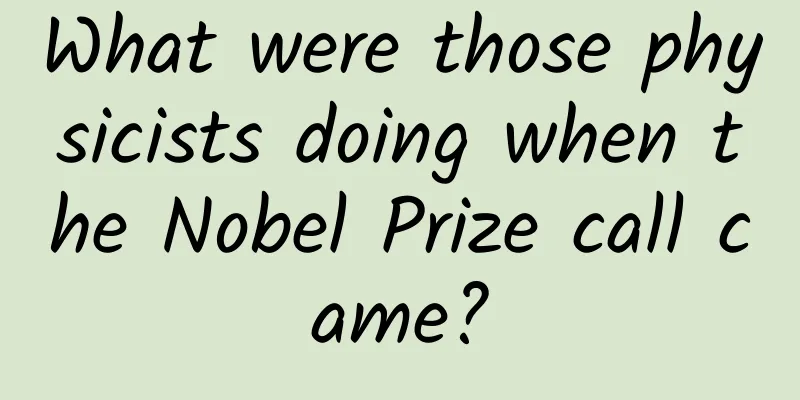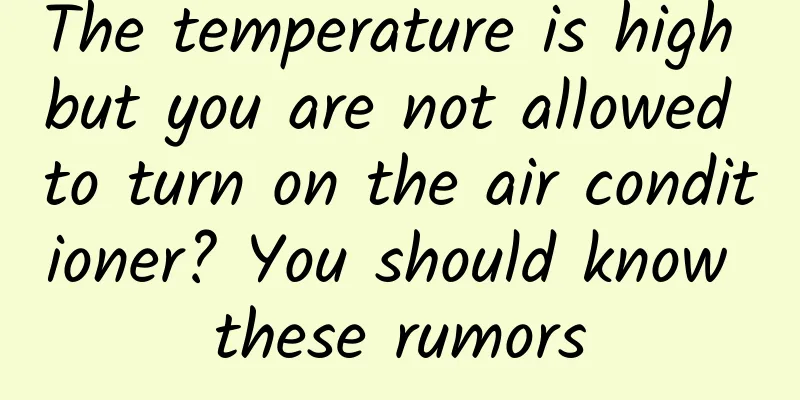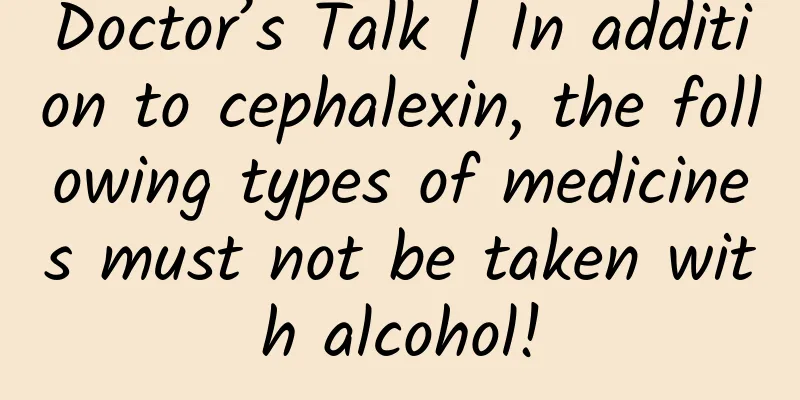What were those physicists doing when the Nobel Prize call came?

|
In a sense, the moment they win the Nobel Prize is the moment that changes their lives. So, what are they doing at that moment? Written by | Snow It's the Nobel Prize season again. At least in terms of natural sciences, the Nobel Prize is now like a final boss. Before the call from Sweden, several awards came one after another, some of which had attractive names - "Nobel Prize Weathervane". Only when the Nobel Prize is actually announced, the scientific feast of the year is over. Undoubtedly, the happiest people are the winners, who actually know that if they have done truly groundbreaking work, they can secretly think about this award. In the end, some lucky people appeared, and the sudden call broke their peaceful life in the past. What were they doing at that moment? Thanks to those recorders, we are able to understand the life of scientists who have gone down in history. This article tells about the Nobel Prize moments of several famous physicists, just as an appetizer for self-entertainment. (What does it have to do with me?) Otherwise, just refuse it? The 1965 Nobel Prize in Physics was awarded to Sin-Itiro Tomonaga (1906-1979), Schwinger (1918-1994) and Richard Feynman (1918-1988) for "their fundamental work in quantum electrodynamics, which has had a profound impact on the physics of elementary particles." In the 1960s, with the progress of various particle experiments, the predictions of quantum electrodynamics (QED) were verified. Therefore, when the time came, there would be some calls for the award in the physics community, but the Nobel Prize was awarded with regret [Note 1]. As a scientific kid, people certainly wanted to know what Feynman was doing that day, and he himself clearly recorded it in the book that he did not admit was an autobiography. At 4 a.m. (or maybe 3:30 a.m.) on October 21, Feynman was woken up by a phone call. He clearly remembered that time and he directly said to the person on the other end of the phone, "Why are you bothering me so early in the morning?" When he learned that he had won the Nobel Prize, Feynman replied, "But I'm sleeping! Just call me in the morning." Feynman's wife Gweneth Howarth also woke up and asked him what was going on. Feynman told her that he had won the Nobel Prize. Gweneth didn't react because Feynman often joked with his wife, and this time it was real! Then, as is the case with today's winners, the phone was ringing non-stop, and Feynman couldn't take a nap. Unable to bear the annoyance, he simply put the phone aside, thinking about how to stop it all, "Maybe I can refuse to accept it." But he knew that this didn't seem to work, so he hung up the phone again, and then the phone rang - a reporter from Time magazine. Feynman asked him if there was any way to not accept the award? The reporter told Feynman that if he didn't accept the award, it might cause a bigger sensation. Perhaps it was the reporter's honesty that made them talk for 20 minutes, and this conversation that Feynman felt was wonderful was not made public. The questions from reporters were always similar. They wanted to introduce quantum electrodynamics to the public for the first time in history, what it was used for, how it related to computers, etc. Even Feynman couldn't handle it, and finally listened to a reporter's private advice: "If I can explain my work clearly in one minute, it would not be worth the award." That day he also asked the same question to Tomonaga Shin'ichirō. The two congratulated each other on the phone, and Feynman asked: “Can you tell me in layman’s terms what you did to win this award?” "I'm very sleepy." Although he had the thought of rejecting it for a moment, Feynman had a great time when he was invited to Stockholm to receive the award. What he liked most was a party organized by local students, where each Nobel Prize winner was given a "frog medal" and asked to imitate the croaking of frogs. Because Feynman had read his father's book The Frogs (Βάτραχοι, a work by the ancient Greek comedy writer Aristophanes) when he was a child - he had practiced it! "Learn to croak like a frog with me, brek, kek, kek" - he became the person who could croak like a frog the best at the scene. Feynman and his wife at the Nobel Prize Ceremony Ball丨Photo source: see watermark Given Feynman’s personality, it is conceivable that he refused the Nobel Prize simply because he was afraid of temporary trouble. With his outstanding “acting skills”, he would not miss those happy moments. But there was one person who seriously considered refusing the award because he was worried about being overly concerned by the media. He was Feynman’s idol Paul Dirac (1902-1984), who won the award together with Erwin Schrödinger (1887-1961) in 1933 “for discovering a very useful new form of atomic theory”. Dirac did not refuse the proposal. The one who gave him the negative opinion was Ernest Rutherford (1871-1937), the Nobel Prize winner in Chemistry. He said, "If you refuse, more people will pay attention to you." Dirac, who was not good at speaking, did not reveal anything interesting. The next day, major British newspapers squeezed out a small space in the current affairs news, "He is only 31 years old, the youngest theorist ever to win the Physics Prize." [Note 2] In an interview in Stockholm, Dirac was unusually happy to answer questions. When asked about the significance of quantum mechanics to real life, “My job is moot right now.” "But could there be?" "That I don't know. But I don't think so. Anyway, I've been working on this theory for eight years, and now I'm starting to develop a theory about positrons. I'm not interested in literature, I don't go to the theater, I don't listen to music. I'm just concentrating on atomic theory." Apparently Dirac was given many interviews, and he talked a lot when he wanted to. That year, Dirac, Schrödinger, and Werner Heisenberg (1901-1976) all appeared at the Nobel Prize ceremony, which was a glorious moment in the history of the Nobel Prize. At that ceremony, Dirac and Heisenberg each brought their mothers, and Schrödinger brought his wife instead of his lover. 丨Image source: Physics World Accepting honors from his hospital bed Among the great physicists of the 20th century, Landau (1908-1968) would not be absent. But compared with Feynman, the Soviet Landau's award seems a bit sad and warm. Landau suffered a serious car accident on January 7, 1962, and his skull was fractured. In order to save Landau, in addition to doctors and nurses, 87 physicists formed a "physics command center" to guard him day and night. Fortunately, Landau regained consciousness six weeks later, and spoke his first word three months later, and his legendary journey in physics was ruined. Perhaps the Nobel Committee felt the urgency, and they awarded the Nobel Prize that year to Landau alone in recognition of "his pioneering theory of condensed matter, especially liquid helium". Landau proposed two microscopic theories of Bose-type elementary excitations (quasiparticles), constructed the energy spectrum of helium II, and successfully explained the macroscopic superfluidity of liquid helium (4He) at 2.17K; 4He was later considered to be a Bose-type quantum liquid. Landau's work made elementary excitations (quasiparticles) an important paradigm of condensed matter low-temperature physics. And this is just one of the "Landau Ten Commandments". On November 1, Landau received a telegram from the Royal Swedish Academy of Sciences, informing him that he had been awarded the Nobel Prize. The next day, the Swedish ambassador to the Soviet Union went to the hospital, and Landau accepted the congratulations while lying on his sickbed. Reporters then flocked to the hospital, and Landau was happy to answer their questions. He especially told foreign reporters, "This means that the great contribution made by the Soviet people to world progress has once again been universally recognized." Then, he asked the reporters to convey his gratitude to his teacher Niels Bohr (1885-1962) - Landau, who was proud of his talent, respected Bohr very much. "Please convey my gratitude to my teacher Niels Bohr in your publications. I owe him my help in many ways. I think of him now with gratitude." Landau and Bohr at the "Archimedes Day" event at the Physics Department of Moscow State University in 1961. Image source: letopis.msu.ru On December 10, the Nobel Prize ceremony was held in the hospital. This was an exception for Landau to be awarded in the hospital. Landau walked into the hall himself and accepted the medal and certificate presented by the Swedish ambassador, as well as a check for $50,000. Mathematician Mstislav Vsevolodovich Keldysh (1911-1978) [Note 3] stepped forward to congratulate on behalf of the Soviet Academy of Sciences. Landau said, "I congratulate you too, but frankly, I don't envy you." The people present laughed because Keldysh was elected president of the Soviet Academy of Sciences the year before. People knew that he was still the Landau who liked to joke. Landau received the Nobel Prize in the hospital. Image source: nobelru.narod.ru (left); Valery Albertovich Gende-Rote (right) How does it feel to win the Nobel Prize twice? John Bardeen (1908-1991): Thanks. It's better than a hole-in-one. Bardeen is the only scientist to have won the Nobel Prize in Physics twice. In 1956, Bardeen won the prize together with William B. Shockley (1910-1989) and Walter H. Brattain (1902-1987) for their research on semiconductors and the discovery of the transistor effect. In 1972, he won the prize again with two students, Leon N. Cooper (1930-) and John R. Schrieffer (1931-2019), for their joint development of the theory of superconductivity, commonly known as the BCS theory. The first award came unexpectedly. On the morning of November 1, 1956, Bardeen learned from the cheers of his children that he had won the Nobel Prize. At this time, he was frying eggs for his family and excitedly dropped the frying pan on the ground. When he came to his senses, he said to his family, "I think I'd better shave." An interesting report came from the Washington Observer[4], a newspaper in Bardeen’s wife’s hometown: “A local woman’s husband won the Nobel Prize.” The left picture on the cover of Electronics shows Shockley operating the experiment, Bardeen recording the data, and Brattain (right) watching. Brattain himself thought that this did not reflect the real situation. Instead, it should be the right picture, where he is operating, Bardeen is recording, and Shockley is watching the experiment. 丨Image source: Computer History Museum (left); AT&T Archives (right) Although immersed in the joyous celebration, Bardeen was skeptical about winning the award in his heart. He believed that many people on the Nobel Prize Committee were not sure whether this technology was worthy of the award, and even that he should not win the award for the transistor. But this time, the Nobel Prize did not make a mistake, and the significance of the transistor needs no further explanation today. On the other hand, Bardeen's honor came more from his theoretical exploration. His sincere cooperation with Brattain eventually led to the birth of the point contact transistor; and when their group leader Shockley learned about the surface theory proposed by Bardeen and the role of the electrolyte [Note 5] discovered by Brattain by chance, he continued to study silicon semiconductors and eventually independently invented the junction transistor, which was also the beginning of today's truly practical transistor. The first point-contact transistor | Image source: britannica.com Bardeen also has other goals in his mind that are comparable to the Nobel Prize - a hole-in-one. Bardeen was a golf enthusiast, and soon after winning the Nobel Prize, he realized his dream of a hole-in-one. That happened to be done at a college golf course in Illinois. When Bardeen was later asked which achievement was greater, the Nobel Prize or the hole-in-one, he replied: “Maybe two Nobel Prizes are worth more than a hole-in-one.” As for the relationship between golf and scientific research, it is probably because there are occasional surprises in the process, but failures (several strokes miss the target) are common. Such long-term training can allow players to maintain an optimistic mood and confidence to cope with more difficult challenges. The work that won the award for the second time is exactly what is popular today. In the 1940s and 1950s, theoretical exploration of superconductivity research achieved breakthroughs, and Feynman and Landau mentioned above also made contributions. Bardeen and his two colleagues established the theory of low-temperature superconductivity based on their predecessors, which can perfectly explain the superconductivity phenomenon discovered by Heike Kamerlingh Onnes (1853-1926) in 1911; based on the BCS theory, physicists discovered the superconducting tunneling phenomenon and the Josephson effect, so Bardeen's second call for the award has increased. In order to allow his two students to win the award, Bardeen wrote a letter to the Nobel Prize Committee in 1967, recommending those who continued the BCS theory, Leo Esaki (1925-), Ivar Giaever (1929) and Brian Josephson (1940-). These three also won the award in 1973. Cooper (left), Bardeen and Schrieffer | Image source: nytimes.com On October 19, 1972, Bardeen learned from a Swedish reporter that he had won the prize again, but he did not believe it because there were always rumors. But the next day, he was awakened by a call from the Nobel Prize official, and his peaceful life was broken again. When Bardeen left home, the electric door of the garage suddenly broke down. The excited reporters noted that the inventor of the transistor was trapped because of the failure of the transistor. He hurriedly explained, "The problem is not the transistor, but the switch outside the door." There was a rumor that he was supposed to give a lecture on superconductivity that day. A reporter followed him into the classroom and heard Bardeen say: "I think it's appropriate to discuss the issue of superconductivity now." Bardin playing golf | Image source: materials.typepad.com So far, Bardeen is the only scientist who has won two physics prizes, but he does not have legendary anecdotes like Feynman and Landau, nor is he good at speaking. But he did the right thing at the right time, without being so dramatic, and is a true genius [Note 6]. A missed win-win moment The 1999 Nobel Prize winner in Physics, Dutch physicist Gerardus 't Hooft (1946-), learned that he had won the prize while giving a report. This special moment should have been a double celebration. His friend, Italian physicist Antonino Zichichi (1929-), firmly believed that he would win the Nobel Prize in 1998, so he invited him to the University of Bologna to receive an honorary doctorate, and arranged it on the day the Nobel Prize was announced. However, contrary to expectations, the Nobel Prize that year was given to the three physicists who discovered the fractional quantum Hall effect. When it comes to predicting failures, the Nobel Prize never disappoints. 't Hooft and Veltman at the Nobel Prize ceremony | Image source: Nobel Prize The following year, 't Hooft was invited by Zichichi again, and he was giving a speech on the day of the award ceremony. After the speech, the applause was particularly enthusiastic. He himself was wondering if what he had said was not so good. In fact, some students left the venue, learned the latest news on the Internet, printed out the news, and then quietly projected it on the screen. Only 't Hooft himself did not know because he had his back to the screen. “They said, ‘Look at your screen,’ and that’s when I realized this was going to be a special moment in my life.” On the other hand, it is not uncommon for Nobel Prizes to be unavailable. No one could find 't Hooft, and the staff eventually found his sister, who spoke Italian, and she called the University of Bologna and found the winner. 't Hooft and his mentor Martinus JG Veltman (1931-2021) were awarded the prize "for elucidating the quantum structure of the electroweak interaction in physics". The 1965 Nobel Prize was won by Feynman and others for revealing the quantum structure of electromagnetic interactions, and now the quantum structure of the electroweak interaction has arrived. For the latter, physicists describe it with non-Abelian gauge fields and predict that it will be renormalizable like Abelian gauge fields. This difficult task was truly proved by 't Hooft and Veltman, who established the theory of particle physics on a more solid mathematical foundation. When 't Hooft participated in this research, he was only 22 years old and had just started his doctorate. Two years later, they solved the problem. He also discovered the asymptotic freedom of strong interactions, but he did not publish a paper. This work won the Nobel Prize in 2004 for others. However, if you want to be a bad physicist, you might want to talk to him [Note 7]. Want to prepare? Since the Nobel Prize is often awarded to work that has been tested for a long time, there are also cases where the winners "forget" their work. The 2016 Nobel Prize winner J. Michael Kosterlitz (1943-) is one of them. He, David J. Thouless (1934-2019) and Duncan Haldane (1951-) were awarded for "theoretical discoveries in the field of topological phase transitions and topological phases of matter." Kosterlitz's award-winning work is the phase transition of two-dimensional superfluids, which is a typical example of topological defects leading to quantum phase transitions. As the Nobel Prize officials said, they opened the door to an unknown world. The door was opened in the 1970s, and Thouless knew at the time that their work deserved a Nobel Prize, but 40 years passed before they finally won the prize. "But it didn't happen until I was on sabbatical in Finland," Kosterlitz recalled in the interview. "By then, I had completely given up on the idea of winning a Nobel Prize." Kosterlitz received the medal from the King of Sweden. 丨Image source: Nobel Prize The phone call always came so suddenly. Kosterlitz was in the underground parking lot of a shopping mall, about to have beer and sushi. He took out his phone from his pocket and heard a Swedish accent congratulating him on his winning. But he didn't react for a moment, and even when he tried to say something, he couldn't say anything. After 30 seconds of silence, "The only thing I could think of at the end was, 'Jesus.' There are those who are not well prepared, and there are those who are well prepared. Frank Wilczek (1951-) knew that he would win the Nobel Prize - his theory on understanding quarks was experimentally confirmed, and he thought that it would be similar to the time when 't Hooft won the prize. For several years, he couldn't even sleep before the Nobel Prize was awarded. Finally, in 2004, the surprise came, and he, David J. Gross (1941-) and Hugh D. Politzer (1949-) won the prize "for the discovery of asymptotic freedom in the theory of strong interactions." Wilczek's Nobel Prize certificate | Image source: Nobel Prize On October 5, 2004, at 5 a.m. U.S. time (the results were announced at 6 a.m.), he decided that he couldn't sleep anyway, so he took a shower and got ready. What if he really won the prize? Before he walked out of the bathroom, Wilczek's wife came to him with the phone - yes, he answered the phone while wet, and talked with his Swedish colleagues for 20 minutes. "My wife tried to dry me off. So it was a good experience." Afterwards, he called his parents, but his father mistook it for a harassing call and became furious: "Do you know what time it is! What are you going to do? What are you going to sell? Whatever it is, I don't want it!" Indeed, the Nobel Prize notification time is not very friendly to Americans. For the winner, no matter what he is doing at that moment of the day, it will leave a memory. For ordinary people, this memory may be just a gossip, but it may also be an opportunity to get closer to scientists. After all, the difficulty of understanding science today is the distance between the Nobel Prize and ordinary people - it is likely that this is the only part of the press release that the public can understand. For potential scientists, you can make some preparations to some extent, otherwise the above statement will come true. Notes [1] There are always many regrets about the Nobel Prize. Freeman Dyson (1923-2020) did not win the Nobel Prize. Initially, many physicists believed that Dyson only did mathematical integration work, but those who truly understood the relevant issues knew that Dyson had the deepest understanding of quantum field theory and he completed the renormalization program. [2] The youngest winner of the Nobel Prize in Physics is William Lawrence Bragg (1890-1971). At the age of 25, he and his father William Henry Bragg jointly won the 1915 Nobel Prize in recognition of "their work on X-ray analysis of crystal structure." In terms of theorists, Tsung-Dao Lee (1926.11.24-) broke Dirac's record. On November 9, 1933, Dirac received the Nobel Prize call at the age of 31 years and 93 days; on October 31, 1957, the Nobel Prize was announced, and Tsung-Dao Lee was 23 days away from turning 31, making him the second youngest winner of the Physics Prize. [3] Keldysh was a Latvian-born Soviet applied mathematician and mechanics expert who did important work in aerodynamics. His name is closely associated with Soviet defense engineering and space science, and later had a significant impact on the development of the Soviet computer industry. [4] The newspaper is now the Observer–Reporter [5] Because there were always droplets on the experimental equipment that caused experimental errors, Brattain simply soaked the entire set of equipment in water, and found that the electrolyte caused the photovoltaic effect to be amplified. After that, they hoped to introduce the potential by adding electrolyte, and eventually the electrolyte was replaced by germanium semiconductor, realizing the point-contact transistor. [6] Bardeen’s biography, Ture Genius, was translated as “a rare genius”, which is obviously a compromise to the market. In the last chapter of the book, the author discusses the cultivation of a genius from Bardeen. A true genius is different from the genius in cultural tradition. It is fostered by many conditions and has more practical significance. [7] One of his blog posts, https://webspace.science.uu.nl/~hooft101/theoristbad.html References Richard. P. Feynman, Ralph Leighton, "Surely you're joking, Mr. Feynman." (2018). J. Gleick, Translated by Huang Xiaoling, Biography of Feynman, Higher Education Press, July 2014. Graham Farmelo, Translated by Qiu Taotao, Quantum Genius: A Biography of Paul Dirac, CITIC Press, May 2022 https://www.nobelprize.org/prizes/physics/1962/ceremony-speech/ Appreciation of Landau's superfluidity theory, https://mp.weixin.qq.com/s/afhvSmJCn6db8zsfNS5X_w Written by Maya Bessarabi, translated by Li Xueying, Biography of Landau, Higher Education Press, 2018.11 http://www.prometeus.nsc.ru/archives/exhibits/landau/pagelif6.ssi#ch08 Lilian Hoddenson Vicki Daitch, Wen Huijing, Shen Heng, Translated, The Genius of the Century: The Biography of Bardeen, Shanghai Science and Technology Education Press, 2007.7 Liu Shuyong, Wang Xiaoyi. "A scientific genius with mixed reputations: In commemoration of the 100th anniversary of William Shockley's birth." Communications in Dialectics of Nature 32.03(2010):98-107+128. https://www.aip.org/history-programs/niels-bohr-library/oral-histories/47016 Zhang Zhaoxi. "Renormalization theory of non-Abelian gauge fields: an introduction to the 1999 Nobel Prize in Physics". Physics. 02(2000): 76-77. https://www.nobelprize.org/prizes/physics/1999/press-release/ The Nobel Prize for Topological Quantum State Theory is well deserved | Wen Xiaogang's comments https://mp.weixin.qq.com/s/4kFBLHFf7VAr860h-Rgeig https://www.aip.org/history-programs/niels-bohr-library/oral-histories/47183 https://www.aip.org/history-programs/niels-bohr-library/oral-histories/44536 Produced by: Science Popularization China Special Tips 1. Go to the "Featured Column" at the bottom of the menu of the "Fanpu" WeChat public account to read a series of popular science articles on different topics. 2. Fanpu provides a function to search articles by month. Follow the official account and reply with the four-digit year + month, such as "1903", to get the article index for March 2019, and so on. Copyright statement: Personal forwarding is welcome. Any form of media or organization is not allowed to reprint or excerpt without authorization. For reprint authorization, please contact the backstage of the "Fanpu" WeChat public account. |
<<: Today, let us pay tribute to them together!
>>: 10 years, from 0 to 3...丨Technology of a great country
Recommend
World Hepatitis Day | Don’t take it lightly! More than 300 million people are infected nationwide, and it has nothing to do with being fat or thin!
Today (July 28) is World Hepatitis Day. At presen...
Japanese smart TVs are criticized: buying a large display at a high price
With excellent user interface and massive content ...
Live broadcast room retention and conversion skills: live broadcast props
What I’m going to share with you today is “ Live ...
5 steps + 7 tips to teach you how to create high-conversion information flow copy!
In the past two years, information flow advertisi...
April's new media marketing hot spots calendar is out!
April is on its way. The most beautiful April day...
How does Tmall create anthropomorphic IP?
People say that the "New Year atmosphere&quo...
Mobile phone recycling machine: valuation + recycling in just 3 minutes
A cooking robot stir-fries a plate of shrimp in 2 ...
The mainstream and non-mainstream sentiments of “making mobile phones” from PP King
Apple's autumn new product launch conference ...
iOS 11 installation rate has reached 59%, but it is lower than iOS 10 during the same period
On December 6, according to foreign media reports...
"Bohemian Rhapsody" - Why is it named Bohemia?
Friends around me have been recommending me to wa...
"Blue Fire Micro-Course Lecturer Practical Training Camp" You can easily teach and make money even if you are not a lecturer
Absolutely useful information, based on 3 years o...
The era is over! Netizens say that Symbian phones can no longer log in to QQ/WeChat
From the arcade N73, to the T9 flagship N95, to t...
Advancing towards the center of the earth: Is it necessary to go deep into the ground ten thousand meters deep?
Produced by: Science Popularization China Author:...
Who is the first animal in the world to make active sounds? When life began to chirp
Author: Global Science We are used to the fact th...
A brief analysis of the necessity and construction methods of the user growth system for B-end products
Compared with C-end products that have made great...









